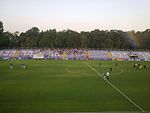2001 Azor attack
21st-century mass murder in IsraelFebruary 2001 crimesFebruary 2001 events in AsiaHamas attacksMass murder in 2001 ... and 2 more
Terrorist incidents in Israel in 2001Terrorist incidents involving vehicular attacks

On 14 February 2001, a vehicular attack took place near Azor, Israel. A Palestinian man from Gaza drove a bus into a group of Israeli soldiers who stood at a bus stop at Azor junction, killing 8 people—7 soldiers and one civilian, and injuring 26 further. The Islamist militant organization Hamas claimed responsibility for the attack.
Excerpt from the Wikipedia article 2001 Azor attack (License: CC BY-SA 3.0, Authors, Images).2001 Azor attack
HaMelakha, Holon Industrial Zone B
Geographical coordinates (GPS) Address Nearby Places Show on map
Geographical coordinates (GPS)
| Latitude | Longitude |
|---|---|
| N 32.021111111111 ° | E 34.805833333333 ° |
Address
המלאכה
HaMelakha
5800239 Holon, Industrial Zone B
Tel-Aviv District, Israel
Open on Google Maps










